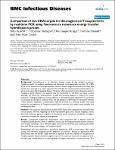Comparison of two DNA targets for the diagnosis of Toxoplasmosis by real-time PCR using fluorescence resonance energy transfer hybridization probes
Reischl, Udo
Bretagne, Stéphane
Krüger, Dominique
Ernault, Pauline
Costa, Jean-Marc
Background: Toxoplasmosis is an infectious disease caused by the parasitic protozoan Toxoplasma gondii. It is endemic worldwide and, depending on the geographic location, 15 to 85% of the human population are asymptomatically infected. Routine diagnosis is based on serology. The parasite has emerged as a major opportunistic pathogen for immunocompromised patients, in whom it can cause life-threatening disease. Moreover, when a pregnant woman develops a primary Toxoplasma gondii infection, the parasite may be transmitted to the fetus and cause serious damage. For these two subpopulations, a rapid and accurate diagnosis is required to initiate treatment. Serological diagnosis of active infection is unreliable because reactivation is not always accompanied by changes in antibody levels, and the presence of IgM does not necessarily indicate recent infection. Application of quantitative PCR has evolved as a sensitive, specific, and rapid method for the detection of Toxoplasma gondii DNA in amniotic fluid, blood, tissue samples, and cerebrospinal fluid. Methods: Two separate, real-time fluorescence PCR assays were designed and evaluated with clinical samples. The first, targeting the 35-fold repeated B1 gene, and a second, targeting a newly described multicopy genomic fragment of Toxoplasma gondii. Amplicons of different intragenic copies were analyzed for sequence heterogeneity. Results: Comparative LightCycler experiments were conducted with a dilution series of Toxoplasma gondii genomic DNA, 5 reference strains, and 51 Toxoplasma gondii-positive amniotic fluid samples revealing a 10 to 100-fold higher sensitivity for the PCR assay targeting the newly described 529-bp repeat element of Toxoplasma gondii. Conclusion: We have developed a quantitative LightCycler PCR protocol which offer rapid cycling with real-time, sequence-specific detection of amplicons. Results of quantitative PCR demonstrate that the 529-bp repeat element is repeated more than 300-fold in the genome of Toxoplasma gondii. Since individual intragenic copies of the target are conserved on sequence level, the high copy number leads to an ultimate level of analytical sensitivity in routine practice. This newly described 529-bp repeat element should be preferred to less repeated or more divergent target sequences in order to improve the sensitivity of PCR tests for the diagnosis of toxoplasmosis.
No license information

